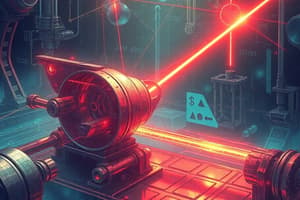Podcast
Questions and Answers
What is the unit of pressure?
What is the unit of pressure?
- Kilogram (kg)
- Joule (J)
- Newton (N)
- Pascal (Pa) (correct)
Which equation represents Pascal's law?
Which equation represents Pascal's law?
- $E = mc^2$
- $P = \frac{F}{A}$
- $P_1 = P_2$ (correct)
- $F = ma$
In which field do physicists study the behavior of matter under various forces and pressures?
In which field do physicists study the behavior of matter under various forces and pressures?
- Astronomy
- Biology
- Chemistry
- Physics (correct)
How do engineers use force and pressure?
How do engineers use force and pressure?
What is the relationship between force and pressure according to Pascal's law?
What is the relationship between force and pressure according to Pascal's law?
What is the main difference between force and pressure?
What is the main difference between force and pressure?
Which physicist developed the laws of motion that describe the relationship between force and mass?
Which physicist developed the laws of motion that describe the relationship between force and mass?
What does Newton's second law of motion state?
What does Newton's second law of motion state?
What is the unit of force?
What is the unit of force?
What letter is typically used to represent pressure in physics?
What letter is typically used to represent pressure in physics?
Study Notes
Force and Pressure
Introduction
Force and pressure are two related but distinct concepts that are fundamental to understanding the behavior of matter. Force is a push or pull on an object that causes it to accelerate or move, while pressure is the intensity of force applied per unit area. In this article, we will explore the definitions, units, and equations related to force and pressure, as well as their applications and real-world examples.
Force
Definition
Force is a push or pull on an object that causes it to accelerate or move. It is a vector quantity, which means it has both magnitude and direction. In physics, force is typically represented by the letter F.
Units
The unit of force is the Newton (N), which is named after Sir Isaac Newton, the English physicist who developed the laws of motion. One Newton is the force required to accelerate a mass of one kilogram at a rate of one meter per second squared.
Equations
The relationship between force and mass is described by Newton's second law of motion, which states that the force acting on an object is equal to the mass of the object multiplied by its acceleration. Mathematically, this can be represented as:
$$F = ma$$
where:
- F is the force,
- m is the mass,
- a is the acceleration.
Pressure
Definition
Pressure is the intensity of force applied per unit area. It is a scalar quantity, which means it has only magnitude, not direction. In physics, pressure is typically represented by the letter P.
Units
The unit of pressure is the Pascal (Pa), which is the pressure required to support a mass of one Newton spread over an area of one square meter. Mathematically, this can be represented as:
$$P = \frac{F}{A}$$
where:
- P is the pressure,
- F is the force,
- A is the area.
Equations
The relationship between force and pressure can be described by Pascal's law, which states that an increase in pressure at any point in a confined fluid is transmitted undiminished to every other point in the fluid and to the walls of the container. Mathematically, this can be represented as:
$$P_1 = P_2$$
where:
- P1 is the pressure at a point in the fluid,
- P2 is the pressure at any other point in the fluid.
Applications and Real-World Examples
Force and pressure play a crucial role in various fields, including engineering, physics, and everyday life. Some examples include:
-
Engineering: Engineers use the principles of force and pressure to design structures, machines, and other devices that can withstand specific loads and pressures.
-
Physics: Physicists study the behavior of matter under various forces and pressures to understand the fundamental laws of nature.
-
Everyday Life: We encounter force and pressure in our daily lives, such as when we apply force to open a door or when we feel the pressure of the air around us.
Conclusion
Force and pressure are essential concepts in the study of matter and the physical world. By understanding the definitions, units, and equations related to force and pressure, we can gain a deeper appreciation for the principles that govern the behavior of matter and the forces that shape our world.
Studying That Suits You
Use AI to generate personalized quizzes and flashcards to suit your learning preferences.
Description
Explore the definitions, units, and equations related to force and pressure, as well as their applications and real-world examples. Understand the fundamental principles that govern the behavior of matter and the forces that shape the physical world.




